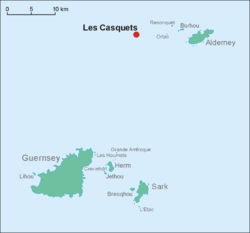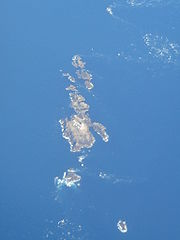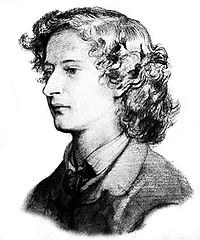
Casquets
Encyclopedia

Islet
An islet is a very small island.- Types :As suggested by its origin as islette, an Old French diminutive of "isle", use of the term implies small size, but little attention is given to drawing an upper limit on its applicability....
s 13 km northwest of Alderney
Alderney
Alderney is the most northerly of the Channel Islands. It is part of the Bailiwick of Guernsey, a British Crown dependency. It is long and wide. The area is , making it the third-largest island of the Channel Islands, and the second largest in the Bailiwick...
and are part of an underwater sandstone
Sandstone
Sandstone is a sedimentary rock composed mainly of sand-sized minerals or rock grains.Most sandstone is composed of quartz and/or feldspar because these are the most common minerals in the Earth's crust. Like sand, sandstone may be any colour, but the most common colours are tan, brown, yellow,...
ridge. Other parts which emerge above the water are the islets of Burhou
Burhou
Burhou is a small island approximately 1.4 miles northwest of Alderney that is part of the Channel Islands. It has no permanent residents, and is a bird sanctuary, so landing there is banned from March 15 to July 27...
and Ortac
Ortac
Ortac is a small uninhabited islet about 5 km West of the coast of Alderney near to the islet of Burhou. It measures approx. 50 by 70 meters....
. Little vegetation grows on them. The "t" is pronounced in English, with the stress on the second syllable (kæsˈkɛts ).
Origin of name
Theories as to the origin of the name include:- derivation from the FrenchFrench languageFrench is a Romance language spoken as a first language in France, the Romandy region in Switzerland, Wallonia and Brussels in Belgium, Monaco, the regions of Quebec and Acadia in Canada, and by various communities elsewhere. Second-language speakers of French are distributed throughout many parts...
'cascade', which alludes to the tidal surges which flow around them; - derivation from 'casque', referring to the helmet-like shape of the rocks;
- derivation from 'cas' (broken) and 'quet' (rock).
A map (Leyland map) dated from around 1640 gives a Latin name Casus Rupes (broken rocks), which would seem to confirm the third theory above, but which may be a folk etymology.
Wrecks
There have been numerous wreckWreck
Wreck may refer to:* Wreck, a ceremony of initiation into the 40 et 8 club* Wreck , an American indie rock band* A collision of an automobile, aircraft or other vehicle* Shipwreck, the remains of a ship after a crisis at sea...
s on the islet
Islet
An islet is a very small island.- Types :As suggested by its origin as islette, an Old French diminutive of "isle", use of the term implies small size, but little attention is given to drawing an upper limit on its applicability....
s; fierce tides reaching 6-7 knots on springs and a lack of landmarks account for many wrecks in the area. The most famous include SS Stella
SS Stella
Stella was a passenger ferry in service with the London and South Western Railway that was wrecked on 30 March 1899 off the Casquets during a crossing from Southampton, to Guernsey.-Construction:...
, wrecked in 1899. The largest wreck was the 8000 tonne water tanker Constantia S lost in 1967.
It was believed for centuries that the loss of HMS Victory
HMS Victory (1737)
HMS Victory was a 100-gun first-rate ship of the line of the Royal Navy, built to the dimensions of the 1733 proposals of the 1719 Establishment at Portsmouth Dockyard, and launched on 23 February 1737.-Construction:...
in 1744 was attributable to wrecking on the Casquets, the lightkeeper of Alderney even being court-martialled for failure to keep the light on at the time of the ship's loss. However, when the wreck of that ship was found in 2008, it was over 60 nautical miles (111.1 km) from the Casquets.
Casquets lighthouses

Lighthouse
A lighthouse is a tower, building, or other type of structure designed to emit light from a system of lamps and lenses or, in older times, from a fire, and used as an aid to navigation for maritime pilots at sea or on inland waterways....
s started operation on 30 October 1724, and were three towers lit by coal
Coal
Coal is a combustible black or brownish-black sedimentary rock usually occurring in rock strata in layers or veins called coal beds or coal seams. The harder forms, such as anthracite coal, can be regarded as metamorphic rock because of later exposure to elevated temperature and pressure...
fires called St Peter, St Thomas and the Dungeon. Three stone
Rock (geology)
In geology, rock or stone is a naturally occurring solid aggregate of minerals and/or mineraloids.The Earth's outer solid layer, the lithosphere, is made of rock. In general rocks are of three types, namely, igneous, sedimentary, and metamorphic...
towers were built to give the lights a distinctive appearance which would not be confused with lighthouses in nearby France
France
The French Republic , The French Republic , The French Republic , (commonly known as France , is a unitary semi-presidential republic in Western Europe with several overseas territories and islands located on other continents and in the Indian, Pacific, and Atlantic oceans. Metropolitan France...
.
They were built by Thomas Le Cocq, owner of the rocks, under licence from Trinity House
Trinity House
The Corporation of Trinity House of Deptford Strond is the official General Lighthouse Authority for England, Wales and other British territorial waters...
and who was paid a halfpenny per ton of ship
Ship
Since the end of the age of sail a ship has been any large buoyant marine vessel. Ships are generally distinguished from boats based on size and cargo or passenger capacity. Ships are used on lakes, seas, and rivers for a variety of activities, such as the transport of people or goods, fishing,...
when vessels passed the rocks and in turn he paid Trinity House 50 pounds per year for the right to run the lighthouses. The lighthouses reverted back to Trinity House in 1785.
They were converted to oil lamps with metal reflectors which were first used on 25 November 1790; and upgraded again with apparatus to rotate a beam of light in 1818. This had a clockwork
Clockwork
A clockwork is the inner workings of either a mechanical clock or a device that operates in a similar fashion. Specifically, the term refers to a mechanical device utilizing a complex series of gears....
mechanism which was wound up every hour and a half and gave one flash every 15 seconds.
The lighthouses were badly damaged and the lantern
Lantern
A lantern is a portable lighting device or mounted light fixture used to illuminate broad areas. Lanterns may also be used for signaling, as 'torches', or as general light sources outdoors . Low light level varieties are used for decoration. The term "lantern" is also used more generically to...
s smashed in a severe storm
Storm
A storm is any disturbed state of an astronomical body's atmosphere, especially affecting its surface, and strongly implying severe weather...
on 31 October 1823. The towers were raised by a further 30 feet (10 m) in 1854, and equipped with 184 kilocandela lamps which gave three slow flashes every half minute. In 1877 the North West Tower was raised again and the lights in the other two towers discontinued.
British
United Kingdom
The United Kingdom of Great Britain and Northern IrelandIn the United Kingdom and Dependencies, other languages have been officially recognised as legitimate autochthonous languages under the European Charter for Regional or Minority Languages...
commando
Commando
In English, the term commando means a specific kind of individual soldier or military unit. In contemporary usage, commando usually means elite light infantry and/or special operations forces units, specializing in amphibious landings, parachuting, rappelling and similar techniques, to conduct and...
s of the Small Scale Raiding Force
Small Scale Raiding Force
No. 62 Commando or the Small Scale Raiding Force was a British Commandos unit of the British Army during the Second World War. The unit was formed around a small group of commandos under the command of the Special Operations Executive...
made two raids during the Second World War on the lighthouse, following the German occupation of the Channel Islands
Occupation of the Channel Islands
The Channel Islands were occupied by Nazi Germany for much of World War II, from 30 June 1940 until the liberation on 9 May 1945. The Channel Islands are two British Crown dependencies and include the bailiwicks of Guernsey and Jersey as well as the smaller islands of Alderney and Sark...
in 1940. The first raid, Operation Dryad
Operation Dryad
Operation Dryad was a raid on the Casquets lighthouse in the Channel islands by British Commandos during the Second World War. The Commandos captured the lighthouse and its occupants and departed leaving no trace that anyone had ever been there.-Background:...
, took place on 2–3 September 1942 and the seven keepers were taken back to England
England
England is a country that is part of the United Kingdom. It shares land borders with Scotland to the north and Wales to the west; the Irish Sea is to the north west, the Celtic Sea to the south west, with the North Sea to the east and the English Channel to the south separating it from continental...
as prisoners of war.
Conversion to electric light took place in 1954, with the installation of a 2,830 kilocandela lamp. The lamp is unusual in that it rotates counter-clockwise. At the same time, the other two towers were reduced in height.
The current light in the 23 metre North West Tower is 37 metres above mean sea level and flashes five times every 30 seconds and with flashes 3.7 seconds apart. It can be seen for around 24 nautical miles (44 km) in clear weather. The East Tower contains the foghorn
Foghorn
A foghorn or fog signal or fog bell is a device that uses sound to warn vehicles of hazards or boats of the presence of other vehicles in foggy conditions. The term is most often used in relation to marine transport...
, which produces two blasts every 60 seconds and this has a nominal range of three nautical miles (6 km). Fog signal permanently discontinued from May 11, 2011. The South West Tower is topped with a helipad
Helipad
Helipad is a common abbreviation for helicopter landing pad, a landing area for helicopters. While helicopters are able to operate on a variety of relatively flat surfaces, a fabricated helipad provides a clearly marked hard surface away from obstacles where a helicopter can safely...
and there is another helipad on a flat section of the rock. The rocks are also marked using racon
Racon
A racon is a radar transponder commonly used to mark maritime navigational hazards. The word is a portmanteau of RAdar and beaCON.When a racon receives a radar pulse, it responds with a signal on the same frequency which puts an image on the radar display...
with a Morse
Morse code
Morse code is a method of transmitting textual information as a series of on-off tones, lights, or clicks that can be directly understood by a skilled listener or observer without special equipment...
letter T on radar
Radar
Radar is an object-detection system which uses radio waves to determine the range, altitude, direction, or speed of objects. It can be used to detect aircraft, ships, spacecraft, guided missiles, motor vehicles, weather formations, and terrain. The radar dish or antenna transmits pulses of radio...
displays. The lighthouse complex was automated in 1990 and is monitored and controlled from the Trinity House Operations Control Centre in Harwich
Harwich
Harwich is a town in Essex, England and one of the Haven ports, located on the coast with the North Sea to the east. It is in the Tendring district. Nearby places include Felixstowe to the northeast, Ipswich to the northwest, Colchester to the southwest and Clacton-on-Sea to the south...
.
The Casquets in literature

Swinburne's Les Casquets
A.C. SwinburneAlgernon Charles Swinburne
Algernon Charles Swinburne was an English poet, playwright, novelist, and critic. He invented the roundel form, wrote several novels, and contributed to the famous Eleventh Edition of the Encyclopaedia Britannica...
's poem, Les Casquets is based on the Houguez family who actually lived on the island for 18 years. The Houguez were originally from Alderney, and the poem describes their life on Les Casquets. The daughter falls in love with a carpenter from Alderney, but moving to his island, finds life there too busy. She finds the "small bright streets of serene St Anne" and "the sight of the works of men" too much, and returns to Les Casquets.
Victor Hugo's L'Homme qui Rit
Victor HugoVictor Hugo
Victor-Marie Hugo was a Frenchpoet, playwright, novelist, essayist, visual artist, statesman, human rights activist and exponent of the Romantic movement in France....
, who lived on Guernsey
Guernsey
Guernsey, officially the Bailiwick of Guernsey is a British Crown dependency in the English Channel off the coast of Normandy.The Bailiwick, as a governing entity, embraces not only all 10 parishes on the Island of Guernsey, but also the islands of Herm, Jethou, Burhou, and Lihou and their islet...
, and who wrote much about the Channel Islands, says in his novel, The Laughing Man
The Man Who Laughs
The Man Who Laughs is a novel by Victor Hugo, originally published in April 1869 under the French title L'Homme qui rit. Also published under the title By Order of the King...
(L'Homme qui Rit):
- "To be wrecked on the Casquets is to be cut into ribbons; to strike on the OrtacOrtacOrtac is a small uninhabited islet about 5 km West of the coast of Alderney near to the islet of Burhou. It measures approx. 50 by 70 meters....
is to be crushed into powder... On a straight frontage, such of that of the Ortac, neither the wave nor the cannon ball can ricochet... if the wave carries the vessel on the rock she breaks on it, and is lost..."

